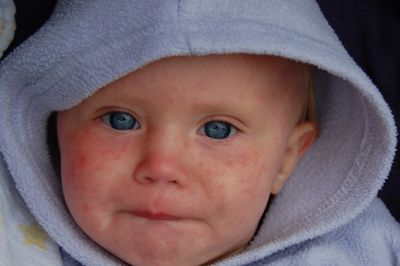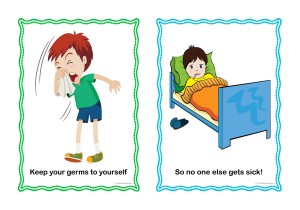Measles is a serious disease that is easily spread through the air. Immunisation is effective in preventing the disease. All children and adults born during or after 1966 should be vaccinated with 2 doses of measles containing vaccine if not already immune.
What is Measles?
Measles is a viral disease that may have serious complications.
In the past, measles infection was very common in childhood. Measles is now rare in NSW because of immunisation but many areas of the world continue to experience outbreaks. In 2008 there were 164,000 deaths worldwide due to measles.
What are the symptoms?
The first symptoms are fever, tiredness, cough, runny nose, sore red eyes and feeling unwell. A few days later a rash appears. The rash starts on the face, spreads down to the body and lasts for 4-7 days. The rash is not itchy.
Up to a third of people with measles have complications. These include ear infections, diarrhoea and pneumonia, and may require hospitalisation. About one in every 1000 people with measles develops encephalitis (swelling of the brain).
How is it spread?
Measles is usually spread when a person breathes in the measles virus that has been coughed or sneezed into the air by an infectious person. Measles is one of the most easily spread of all human infections. Just being in the same room as someone with measles can result in infection.
People with measles are usually infectious from just before the symptoms begin until four days after the rash appears. The time from exposure to becoming sick is usually about 10 days. The rash usually appears around 14 days after exposure.
Who is at risk?
Measles was common before 1966, so most people born before then are immune.
People at risk of measles include:
- people born during or since 1966 who have never had measles and who have not had two doses of measles containing vaccine from the age of 12 months.
- people with a weak immune system (e.g., people who are receiving chemotherapy or radiotherapy for cancer or people who take high-dose steroid medications) even if they have been fully immunised or have had past measles infection.
- people who are not immune and who travel overseas.
How is it prevented?
The best protection against measles is immunisation with two doses of MMR (measles, mumps & rubella) vaccine. This vaccine provides protection against infection with measles, as well as against mumps and rubella.
MMR vaccine should be given to children at age 12 months and a second dose as MMRV (measles, mumps, rubella & varicella) should be given at 18 months of age.
Anyone born during or after 1966 and who has never had measles infection or measles vaccination should see their doctor to make sure that they have had two doses of measles containing vaccine at least four weeks apart.
It is safe to have the vaccine more than twice, so people who are unsure should be vaccinated.
People with measles should stay at home until they are no longer infectious (i.e. until 4 days after the rash starts).
For people who are not immune and have come into contact with a person with measles, infection can sometimes still be prevented with measles containing vaccine if given within 3 days of exposure or with immunoglobulin (a treatment made from blood that protects against measles when injected) within 7 days of exposure.
How is it diagnosed?
Measles is suspected when a person feels unwell, has a cough, runny nose or sore eyes and a fever followed by a rash.
Whenever measles is suspected, a blood test and samples from the nose, throat and urine should be collected to confirm the diagnosis. Confirmation of the diagnosis is important as it allows prompt public health follow-up of other people who are at risk of measles.
How is it treated?
People with measles infection are normally advised to rest, drink plenty of fluids, and take paracetamol to treat the fever. There is no specific treatment.
While a person is infectious with measles it is important that he or she remains at home to reduce the possibility of spreading it to other people.
Disclaimer: This fact sheet is for education purposes only. Please consult with your doctor or other health professional to make sure this information is right for your child.
© - Copyright - New South Wales Ministry of Health for and on behalf of the Crown in right of the State of New South Wales










